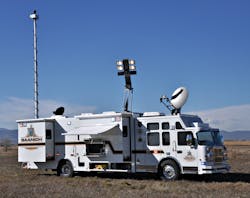What You Need to Know Before Buying a Command Vehicle
After the Sept. 11 attacks more than a decade ago, everyone was scrambling for command vehicles expecting more incidents with protracted responses. From major metropolitan cities, to small suburbs, everyone needed a big vehicle with all the fixings.
Not so much today, but there are still some being built and the ones that are fill niches and some have multiple purposes.
Firehouse talked to a couple of command vehicle builders to get their perspectives on industry trends and what firefighters are looking for when they need a specialized vehicle.
Mike Marquis is the vice president of rescue sales for Rescue 1, a builder in Manasquan, NJ. He’s been in the business for more than 30 years and knows a thing or two about command vehicles. Another respected name in command vehicles is Bob Sorensen, vice president of sales for SVI Trucks, in Fort Collins, CO. He too has decades in the business. And Ed Smith, a member of Hackney Emergency Vehicles' sales team with the territory east of the Mississippi and international sales, also has decades in the business and is considered an expert in the field. Hackney is an apparatus builder in Washington, NC.
All three have different yet similar perspectives on the business. They say there was a period of time when command vehicles were hot, but they have cooled a bit now. They’re still building them, but with some modifications for different missions.
Compartmentalized vehicles
For Marquis, Rescue 1 has seen a recent surge in fire departments that want big, three-compartment command vehicles.
“All of a sudden there’s a spark of interest in three- or four -vehicles,” Marquis said. “We haven’t done one of those in five years, but there’s an interest in them again.”
He said those vehicles have a separate room for communications with three or four operators, another area for a conference room, and another for comfort and rehab, which often has a bathroom, refrigerator and other similar amenities. The three-partitioned units are typically 22 to 24 feet long.
“When we build these, we use an extreme duty interior,” Marquis said. “The people who typically use them are beefy, tough people.”
Marquis recommends departments looking for command vehicles should steer clear of the kind modeled after RVs as they just won’t stand up. RVs are made for people who take care while using them and don’t typically have equipment, big boots and all the trappings of first responders.
He recommends 3/16-inch aluminum, all welded interior surfaces that will take a punishment and last.
“We had one department that was looking at a second command unit because the first one only lasted two years before it fell apart,” Marquis said. “Their bosses were looking at the dollar signs and it ended up costing more because the first one didn’t hold up to the abuse it was getting.”
Moving command to cabs, SUVs
Another trend Marquis has noticed recently, is command units placed in the cabs of custom apparatus. It’s a good option for departments that require an area for command, but can’t justify a full-blown command vehicle. Laptops, booklets, maps, specialized equipment and even refrigerators, can be located in the back of a custom cab.
“Departments should look at what percentage of the vehicle is going to be used as a command vehicle,” Marquis said. “Is it going to be 50 percent or more, or is it going to be 5 or 10 percent? If it’s that small, it doesn’t require the real estate of a big custom command center. These little ones will fit behind the (engine) dog house and work well. They really fill the purpose.”
Marquis said he’s noticed some departments are moving to “fly cars,” which are smaller SUV vehicles, like Ford Explorers or Chevy Tahoes. They’ll have slide-out command centers in the back with storage and communication equipment.
The key to getting what best suits a department is assessing the needs and buying what fits, Marquis said.
“Buying a unit that is like the neighboring town’s unit, is not the best thing to do,” he said. “Each town has its own requirements to meet.”
The best practice is to look at department requirements and have a vehicle custom designed for the need, he said. How many radio consoles are needs, how many people need to sit in a conference area and does the unit need a comfort station are all questions that should be considered.
“Departments like to be independent,” Marquis said. “They don’t want to be the same as other towns.” But that comes with a price and it’s better to meet with OEMS to determine the best fit for the community, he said.
Marquis suggest that department not just look at the cheapest product going either.
“Just because the vehicle cost less doesn’t mean it should be the first choice,” Marquis said. “You can have a 49 cent hamburger from McDonalds or you can get a $10 hamburger. They’re both hamburgers, but they’re not the same. When you want something to last for a longer duration, you pay for exactly that.”
SVI’s Sorensen said he’s noticed fewer command vehicles built lately. In the years immediately after the Sept. 11 attacks, particularly 2005 and 2006, big command units were the trend. The trend now is to support vehicles and retrofitting of existing vehicles.
Technology is improving
“There’s a lot of technology on a command vehicle and, just like we upgrade our electronics at home, taking the analog out and replacing it with digital, fire departments should do the same,” Sorensen said, noting that he’s experienced a lot of that kind of business now.
Another trend he’s seen lately is departments making combination units like Burlington, Ontario, Canada. Sorensen said that department has specified a multi-purpose unit that SVI is building that will serve as a rescue, hazmat and incident command unit.
Another trend Sorensen has noticed lately is police and fire departments partnering to purchase one command unit.
“If a community decided to build some sort of command vehicle, they won’t build it just for the fire department, or just for the police department,” Sorensen said. “If the police want a command unit, they might ask the fire department to join in. That way they have two budgets, versus just one. Going in jointly on a million dollar command vehicle makes it a lot easier to justify.”
When new command units are built, there’s more technology than ever before, Sorensen said, adding that the unit for Burlington will be built to accommodate a drone camera system to capture the entire scene. They can be deployed to hover in a fixed spot until the battery is about to go dead, he said.
Employment of cameras are becoming more prevalent with command vehicles, Sorensen said, noting that incident commanders want to see everything possible while working at a scene. And, not only do they want to see the scene, they want thermal imaging as well, he said.
SVI can put fixed cameras on 42-foot masts and when added to the height of the apparatus, “there’s not too many things you can’t get up and over,” Sorensen said. And the resolution of the cameras are almost unbelievable, he added. While testing cameras at the factory, Sorensen said they are able to see rail car placards at a factory plant a mile and a half away.
Thermal imaging is useful for river rescues as well, Sorensen said, adding that a human in a frozen river is easily visible during rescues.
Another camera trend Sorensen has noted is the use of a technology called AgileMesh, which is a rapidly deployable, remote video surveillance system. Sorensen said initial response officers can deploy the cameras to provide a 360-degree view of the scene, as long as each camera is placed in line of site of the other.
“You can see the A, B, C and D side of any scene and they are remote controlled,” Sorensen said, noting it’s becoming more widely used with command vehicles.
When it comes to sizes of vehicles, Sorensen said they’re not changing much because there are minimum requirements for crew size. He has seen a trend where some fire departments are providing smaller, separate rooms for the public information officer (PIO). He said the PIO will have access to the latest information, but won’t compromise any confidentiality or privileged information that might be discussed in the conference rooms.
In some cases, Sorensen said fire departments are dedicating the back of custom cabs of command units for PIOs. It allows privacy and media access, he said. It’s one of the many advantages of a custom cab command vehicle, he said, adding custom cabs also afford shorter wheelbases, which allow vehicles to get into tighter spaces.
“They’re more money, but they’re worth it," Sorensen said of custom cabs apparatus.
Sorensen said its important fire departments realize command centers are very technology laden and need constant updating and upgrading. That’s why much of SVIs business these days focuses on upfitting and upgrading.
“There is so much stuff that needs to be replaced on older vehicles,” he said. “I don’t think a lot of departments understand how much time and dedication it’s going to take to maintain it.”
He said Edmonton, Alberta, Canada, recently had an issue with a satellite system. It has set for two weeks and when they really needed it, it took 20 minutes for the system to update.
“Just like your TV at home, you can’t use it until the updates are completed,” Sorensen said. It’s best to pull the command unit out every day, ping the satellites, check for updates and do the maintenance.
“Can you imagine pulling up on the scene, turning on the computer and the system says it wants to do a Windows 10 update,” Sorensen said. “It wouldn’t be a very good situation.”
Hackney’s Ed Smith, said he too noticed a significant interest in command vehicles that lasted for several years, but that dried up about five years ago.
“They were a big rage for a while,” Smith said. “They were very expensive with heating and air conditioning and toilets and maybe a few cameras and radios. That was the extent of the technology.”
Smith acknowledged that command vehicles had, and continue to have an important purpose by providing a space for planning and logistics and shelter from the elements. “And it gets people out of the hustle and bustle,” Smith said.
Another drawback for some of the older command vehicles was the sophisticated technology that required IT personnel for operations.
“It is just takes too long to get it up and running,” Smith said.
Faced with that challenge and a declining market, Hackney had to find a way to make a better command vehicle.
Making the vehicles simple
“We had to take that piece of the puzzle out, the part that makes them complicated,” Smith said. Hackney set about to make command vehicles simple and did so by developing a system that required the operator to fire up the generator, push a single acquisition button and then turn on a few lights and the climate control system and everything is up and running.
“You can be up and connected to a satellite in about six or seven minutes,” Smith said, noting it once took an hour to get everything going.
Smith recommends fire departments try to keep things as simple as possible and really examine their needs. If an SUV with one operator will work, that’s the way to go, he said.
“When I start talking to fire departments, I ask them how much money they have, and they think that’s kind of a smart guy question,” Smith said. “I have to know becomes sometimes their expectations outpace their budget.”
Typically, Smith said he asks how many radio operators the department expects to deploy during an incident, and how many people they expect to have in the conference room during the event.
“That will dictate what they need,” Smith said.
Smith, who is close to retiring, said he is actively downsizing and creating a life in which he can live comfortably and he recommends fire departments do the same.
“If you don’t have the money, don’t do it,” Smith said. “It’s that simple.








